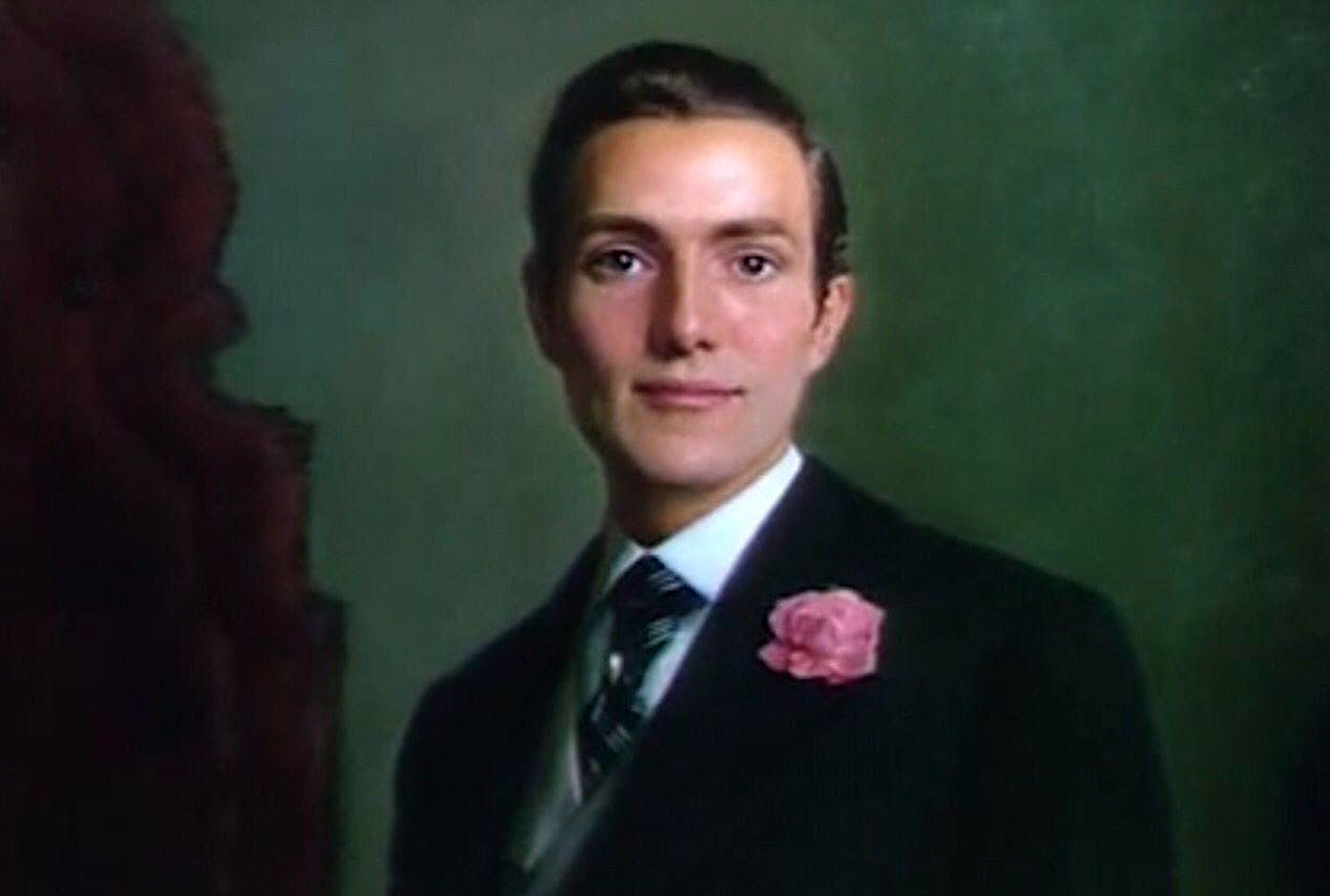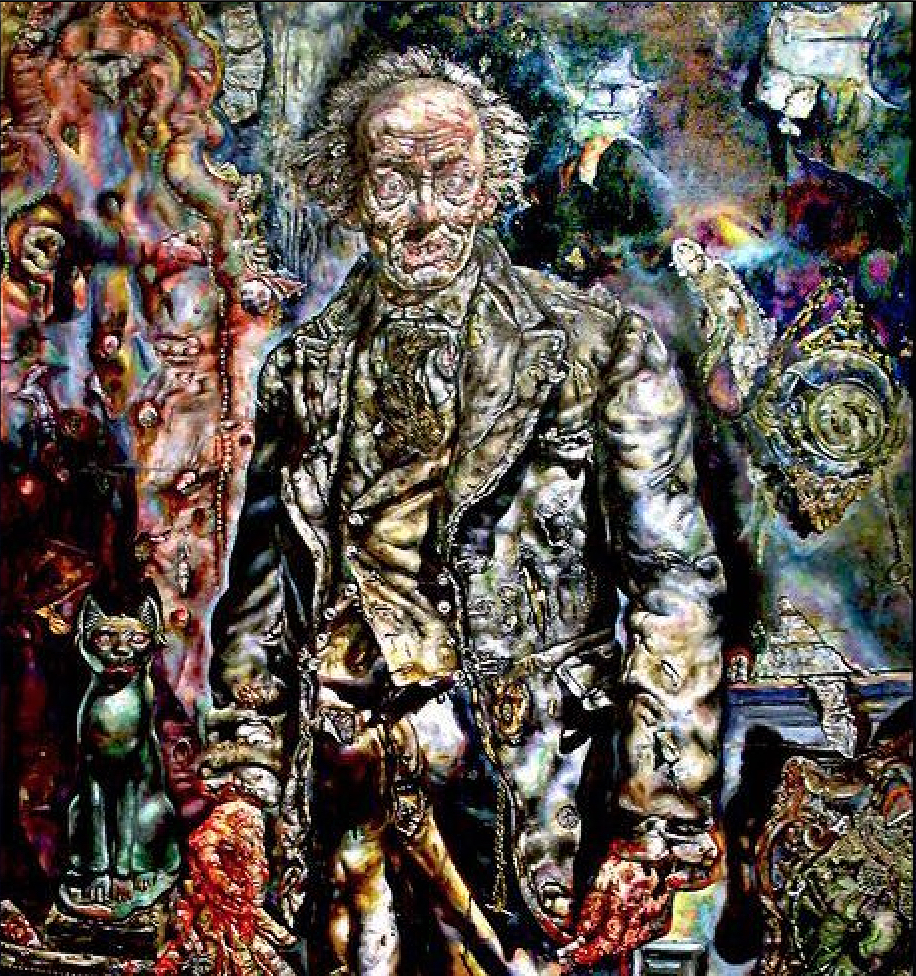Did Scott Alexander receive the same package?

Did Scott Alexander receive the same package?

Until last night I’d never seen Albert Lewin‘s The Picture of Dorian Gray (’45). I’d caught a mid ’70s BBC adaptation but never the Hollywood-stamped film. Lewin directed and wrote the screenplay adaptation of Oscar Wilde’s 1891 novel, and so the dialogue (especially when spoken by George Sanders‘ drolly effete character, “Lord Henry Wotton” character) is delicious.
But what an oddly gayish film…gayish but closeted and corseted to a curious extreme. The face of Hurd Hatfield‘s Dorian Gray isn’t just exquisite to look at, but there’s something else going on — Hatfield’s expression suggests that he’s fully aware of his beauty and his effect upon others, and that’s an unattractive counterweight. He doesn’t seem human, like a robot of some kind. Stiff as a board.


In a 10.20.20 Criterion essay titled “Queer Fear: Dorian the Devil,” Michael Koresky writes that the film “is a central work of ambiguously queer cinematic horror. Like in Wilde’s original, Dorian Gray’s sexuality remains ethereal and slightly unknowable; the ‘love that dared not speak its name’ in late-nineteenth-century England found an easy correspondence with Hays Code–era Hollywood, which forced every inference of homosexuality to exist within winking subterfuges. Just one year after The Uninvited, we have a version of Dorian Gray as a strange, otherworldly being, seemingly incapable of human feeling.”
From a Hurd Hatfield Tumblr page: “Truth be told, Hurd’s so-called ’emotionless’ performance in The Picture of Dorian Gray (1945) was 100% on Albert Lewin’s direction. According to Angela Lansbury, Lewin would stop rolling the cameras once Hatfield registered an obvious expression on his face. Much to Hurd’s frustration because his usual acting style is quite animated, Hurd wanted to perform with more emotion just like the character in the novel. Alas, the director’s power overrides that of the actor’s.
“Film scholars have rationalized Hatfield’s minimalist performance on the notion that his character essentially became the painting itself. Dorian wished to have eternal youth while the picture would age in exchange for his soul, thus the man and painting traded places. The painting has life, it grows old and grotesque as a consequence of Dorian’s actions. Dorian, a man with no soul, lives in shallowness and emptiness as reflected in his mask-like face.
Imagine if N.Y. Times critic A.O. Scott were to start up again with those “Critics Picks” YouTube essays that he was narrating…oh, eight or ten years ago. And then watch this adoring four minute and 19-second essay that he did on Roman Polanski‘s Rosemary’s Baby.
And then imagine that Scott never wrote it and Gabe Johnson never produced it. Do you understand that Scott and Johnson would never compose such a piece today? Because the political climate at the N.Y. Times and throughout wokester culture (which Scott subscribes to body and soul) wouldn’t allow for a favorable Polanski tribute because of the #MeToo vendetta against the 78 year-old director.
If Scott was for some reason ordered by his eccentric editors to re-assess Rosemary’s Baby in a video-essay format, he would adopt an entirely different tack — trust me. Because at the end of the day, all film criticism is political.
Cultures change and consciousness evolves, and this is where we are today — an artist’s unfortunate personal history (which I personally deplore in Polanski’s case) automatically and irrevocably cancels the artistic value of his or her films…period. The idea of judging a flawed but genius-level artist and his/her work on separate planes has been thrown out the window. “Polanski is evil” and so his latest film, J’Accuse, must be indefinitely shunned.
And I mean shunned…you can’t even buy an English-subtitled Bluray or rent a streaming version of same, and it’s easily among my top-five films of 2020. A brilliant investigative drama on the level of Z, a first-rate courtroom drama, a magnificent capturing of 1890s “belle epoque” Paris…crafted with absolute surgical genius…a meticulous, hugely engrossing reconstruction of the Dreyfus affair..a tale told lucidly, clue by clue, layer by layer.
It’s just tragic.
Everyone suspected that Midnight Cowboy would win the 1969 Best Picture Oscar. Because it had sadness, soul, big-city grit, great performances, great music and visual poetry…obviously a deeper, meatier, more ambitious film than Anne of the Thousand Days, Butch Cassidy and the Sundance Kid and Hello, Dolly!, which were also nominated.
But deep down I adored the fifth competitor, Costa Gavras‘ Z, a little bit more than Midnight Cowboy, partly because I was creeped out by the Bob Balaban blowjob scene. I wouldn’t have been the least bit unhappy if Z had won.
Which of the five is the most beloved or most widely seen today? Butch Cassidy, most likely, with Midnight Cowboy a close second. Nobody cares about Hello, Dolly! or Anne of a Thousand Days, and for the most part Z is a low-profile arthouse curio — admired and respected by film connoisseurs but ignored by Joe and Jane Popcorn.
Jon Voight was regarded as a good, gentle soul in the spring of ’70 — he wouldn’t cross over into rightwing lunacy until the dawn of the 21st Century.
For roughly a year we’ve all accepted (or at least have not strenuously argued with) the Wuhan wet market explanation of the origins of the coronavirus pandemic — that it came from contact with dead bats and spread from there. This scenario was fortified, in my mind at least, by the worldwide pandemic in Steven Soderbergh‘s Contagion (2011) also originating with bats.
But last night that presumption shattered into pieces, in my head at least. And it really hurts to give serious weight to this hypothesis because it was initially spread by Orange Plague and Mike Pompeo…Jesus.
On Real Time with Bill Maher, biologist and evolutionary theorist Bret Weinstein, whom I respect for standing up to the Evergreen State College wokesters in 2017, and his wife and colleague Heather Heying, co-authors of “A Hunter-Gatherer’s Guide to the 21st Century”, said that the odds that it did come from a Wuhan lab (specifically the Wuhan Institute of Virology) are roughly 90% — not proven and warranting further study, but very likely.
As I understand it, the theory is that Covid-19 accidentally escaped. Potentially from the Wuhan Institute of Virology but possibly from the Wuhan Center for Disease Control and Prevention — which is located 300 yards south of the Wuhan wet market where the virus allegedly started.
Maher to Weinstein and Heying: “We’ve heard a lot recently about the possibility that the coronavirus did start in a lab. Let’s talk about that. The fact that there is this lab…I think it’s the only one in the world quite like it, [and located] in Wuhan, where the whole thing started. It would almost be a conspiracy theory to think it didn’t start in a lab.
“And that theory was demonized at first — ‘Oh, come on, that’s conspiracy thinking, that it started in the lab.’ But it’s certainly a 50-50…would you say that?”
Weinstein: “Oh, it’s far more likely than that. I think I said last June that the chances it came from a lab were about 90%. This was never a conspiracy theory. In fact that term was used to simply make it go away. It’s an obvious hypothesis that is in need of testing, and we are only now, a year [into the pandemic], getting to the point where we can discuss it out loud without being stigmatized.”
Heying: “Part of the problem is that we are so polarized and partisan in this country, that if the wrong guy” — Trump — “proposed this to begin with, and for half the country it was the wrong way, then [everyone] says ‘no way, no how, we’re gonna call this a conspiracy theory’ and we’re never gonna revisit it.”
Before the 1.6.21 Capitol riot, Sen. Josh Hawley (R-Mo.) had everyone thinking he was a rancid, cynical opportunist — dismissing the obvious legitimacy of the 11.3.20 election in order to win future electoral support from your Trump-supporting, alt-right bumblefucks. Now he’s infamous — a seditious scumbag who deserves to be censured for exploiting paranoid fictions with the same kind of panache that Sen. Joseph McCarthy used to build his notoriety. Should Hawley also be tied to a wagon wheel and horse-whipped?
But Rep. Marjorie Taylor Greene (Georgia’s 14th) is next-level cray cray — a case of lunatic exhibitionism and rightwing “theatre” who spins figure-eights around Hawley — full QAnon, “Trump Won”, questioning the Sandy Hook and Parkland massacres, 9/11 conspiracy theories, Facebook support for shooting Nancy Pelosi, filed articles of impeachment against President Biden the day after his inauguration, etc. Psychotic, venal, troublemaker — all about playing to the idiot prejudices of the northwest Georgia yahoos who voted her in.